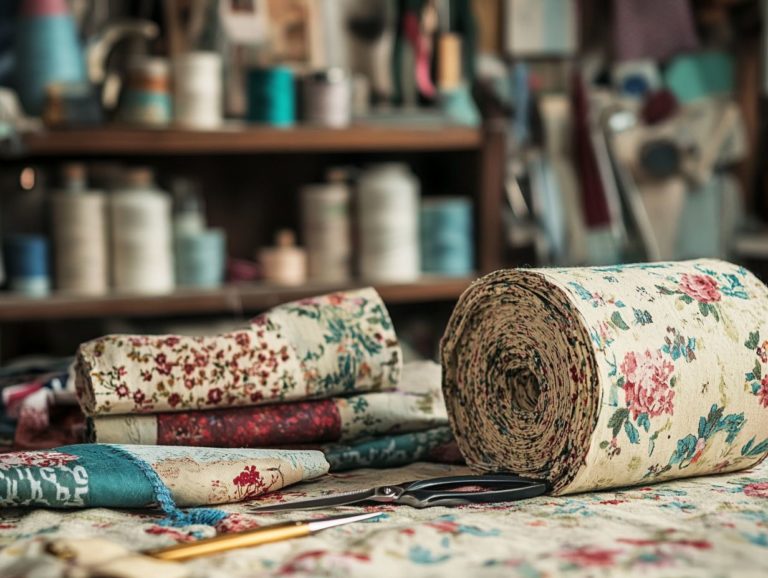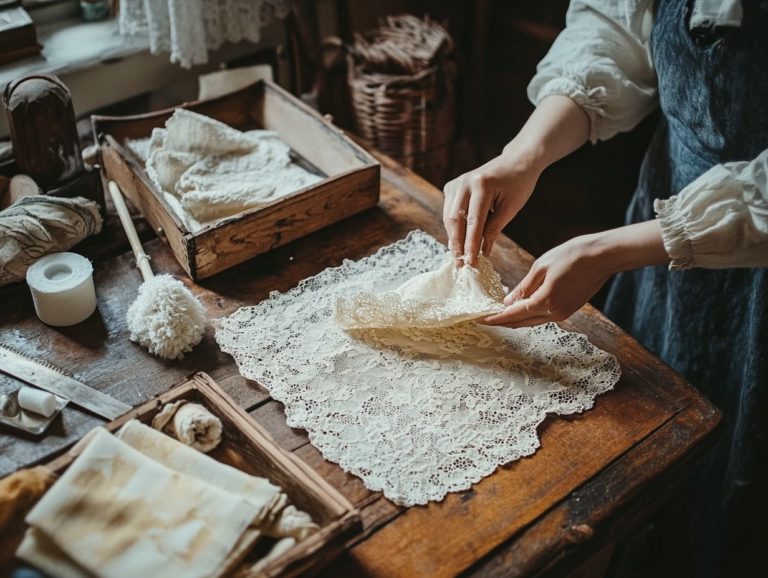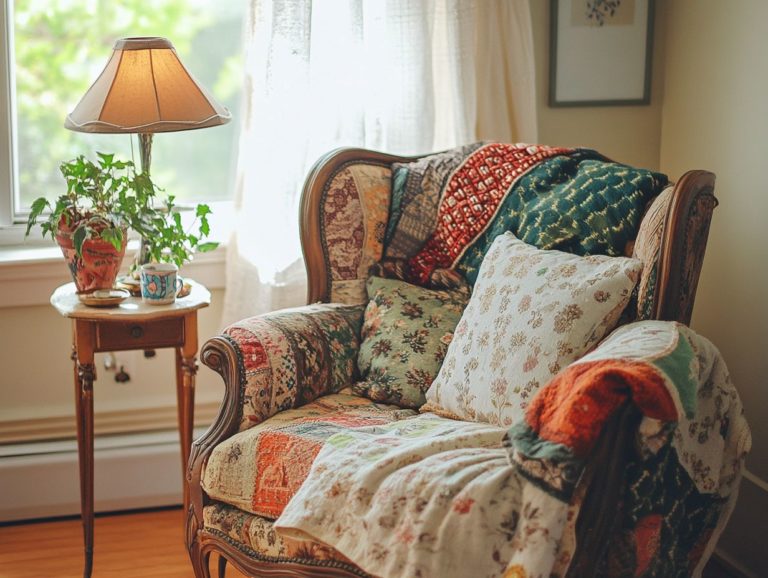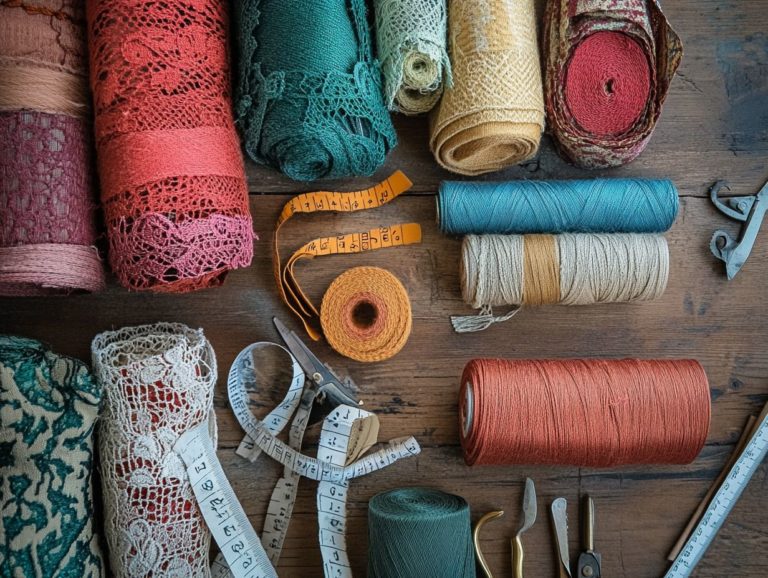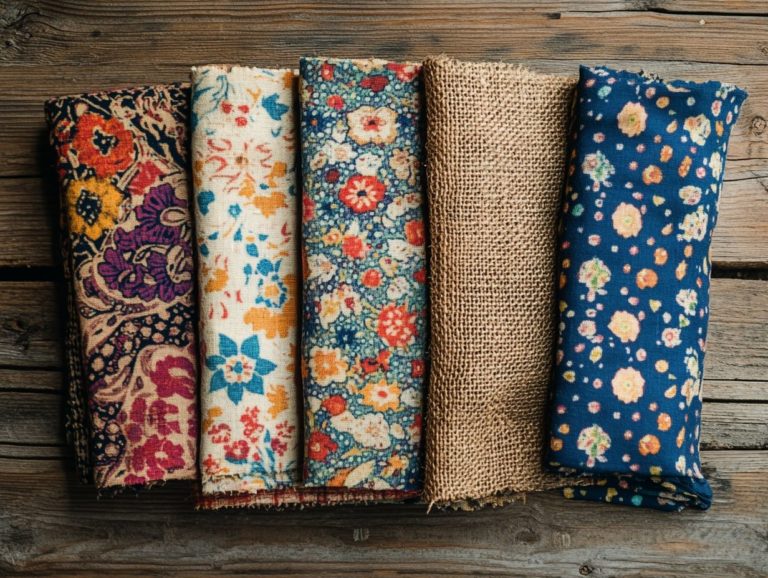Exploring the Textures of Vintage Fabrics
Vintage fabrics possess a unique charm that goes beyond just age. They offer a window into the artistry and craftsmanship of eras long past, showcasing their historical significance in the world of fashion.
What exactly makes a fabric vintage ? This guide helps you understand the materials used, such as cotton, silk, and wool, that characterize these timeless textiles.
You will learn how to identify and appreciate vintage fabrics by exploring the distinction between natural and synthetic materials, as well as the various types of absorbent fabrics and their unique characteristics that tell their own stories.
Discover best practices for preserving these treasures, gain insights on how to seamlessly incorporate them into modern fashion, and find your next vintage gem with resources like the Vintage Fashion Guild and Fabrics.net.
Dive into the fascinating world of vintage fabrics and let your appreciation for these timeless pieces flourish. To enhance your collection, discover where to find authentic vintage fabrics and understand the techniques required for their care and preservation!
Contents
Key Takeaways:
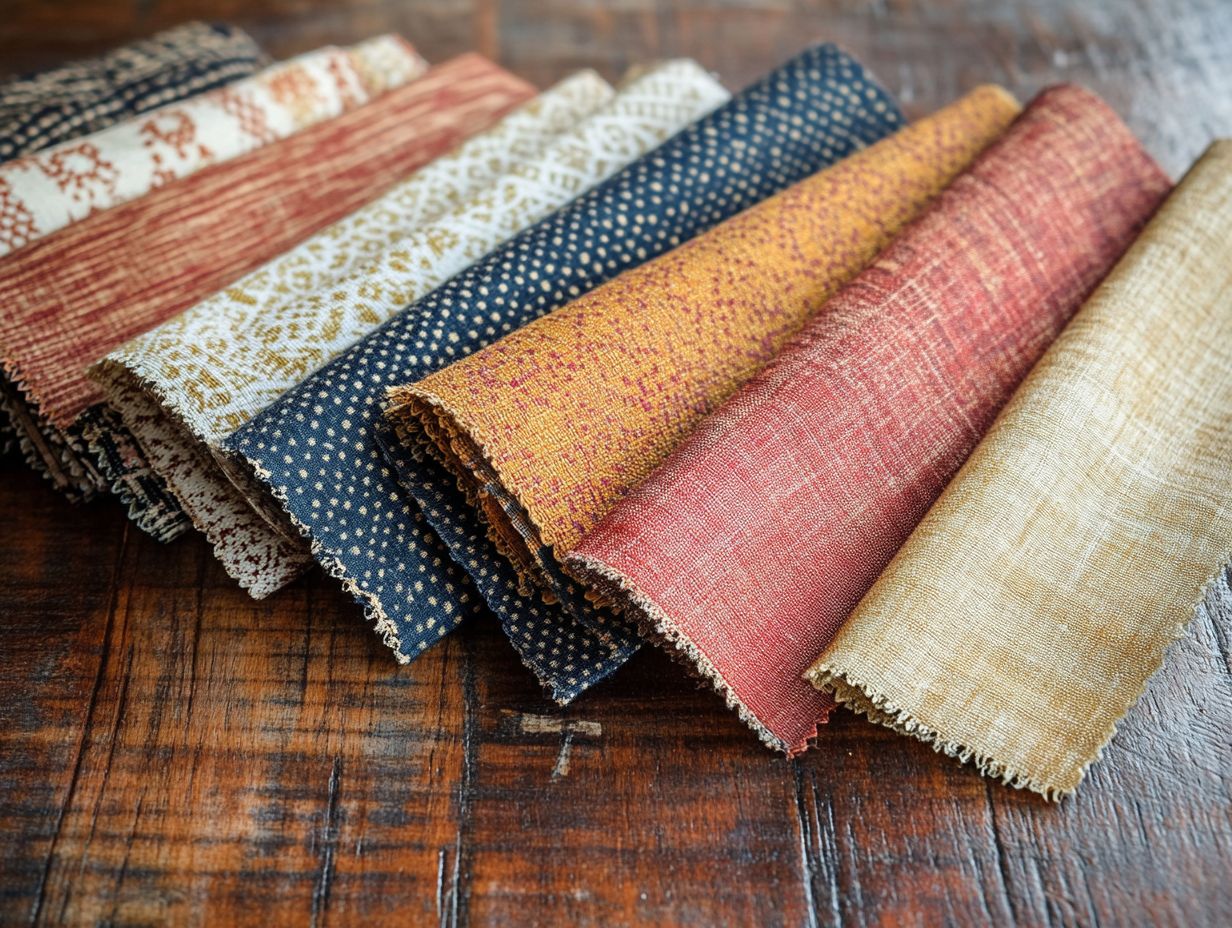
- Vintage fabrics are usually 20 years old or older and are known for their unique textures.
- Natural fabrics like cotton and silk were popular, while synthetic fabrics like polyester and acrylic became common in the mid-20th century.
- To care for vintage fabrics, use gentle cleaning methods and avoid harsh chemicals.
What Makes a Fabric Vintage?
Understanding what defines a fabric as vintage goes beyond just age; it involves various factors including the materials used, such as cotton and silk, the manufacturing techniques, and the design aesthetics characteristic of a specific historical period.
Vintage fabrics are often distinguished by their unique textures, captivating colors, and intricate patterns. Each piece can evoke nostalgia and serve as a canvas for artistic expression, showcasing craftsmanship reflective of its history. To learn more about these materials, check out our guide on understanding different types of vintage furniture fabrics.
Experts appreciate that vintage fabrics whether crafted from natural fibers like cotton, silk, and wool or synthetic materials like nylon and polyester exhibit distinct qualities that set them apart from contemporary textiles, including flexibility and durability.
Defining and Identifying Vintage Fabrics
Identifying vintage fabrics requires understanding specific characteristics, such as production techniques and quality of materials that distinguish them from modern textiles.
From intricate weaving techniques that highlight artisan craftsmanship to the high-quality fibers defining their structure, vintage textiles narrate a story through their texture. Patterns like paisley or florals, often found in historical advertisements, can provide valuable insights into a fabric’s era. Additionally, sourcing vintage textiles for DIY projects appeals to collectors and enthusiasts alike.
When assessing swatches, pay attention to the weight and sheen of the fabric, as these qualities often contrast sharply with contemporary options. Consulting historical references, including textile books, can help authenticate these materials. For those looking for inspiration or sourcing, check out the best vintage fabric resources online to guide you through the intricate maze of fabrics to ensure your collection remains genuine and valuable.
Types of Vintage Fabrics
Vintage fabrics can be categorized into two main types: natural including cotton, silk, and linen and synthetic like polyester and acrylic. Each type possesses distinct characteristics and carries its own historical significance, enriching your understanding and appreciation of these timeless textiles.
Start exploring vintage fabrics today and discover your own unique style!
Natural vs. Synthetic Fabrics
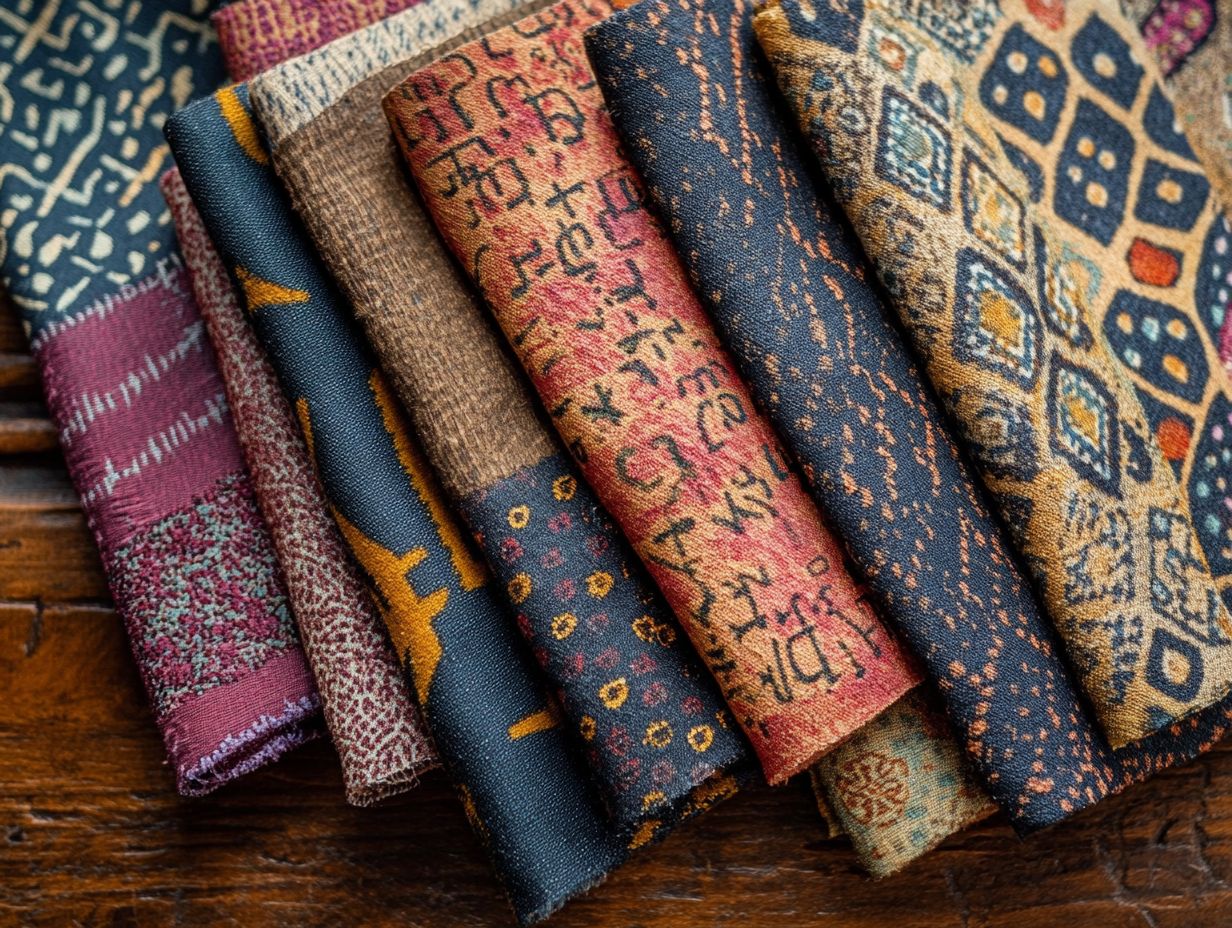
Natural fabrics like cotton, silk, and linen are cherished in vintage fashion for their ability to let air in and comfort. In contrast, synthetic options like polyester and acrylic have become popular due to their durability, bright colors, and dull finishes.
Natural fabrics evoke a sense of tradition and genuineness, especially for vintage enthusiasts who value the artistry of handwoven vintage fabrics and their historical context. Synthetic alternatives offer modern advantages, like being easy to clean, aligning with contemporary lifestyles.
Vintage silk items boast a luxurious sheen and delicate touch, but they often lack the strength to withstand everyday wear compared to synthetic fabrics. On the other hand, vintage polyester garments resist wrinkles and come in a broader range of colors and patterns, making them a great choice for mixing patterns that appeal to a diverse audience that values both quality and style.
When you consider these factors, you ll truly appreciate the distinctive qualities that each fabric type contributes to the world of vintage fashion, enhancing your collection.
Common Vintage Textures
Common textures found in vintage fabrics, like satin and organza, can greatly influence the aesthetic and feel of your designs, shaping your choices for garments and home decor.
These textures tell their own stories. They evoke nostalgia, connecting the past with the present in a beautiful way. Satin, with its luxurious sheen often highlighted in fashion illustrations, has adorned the wardrobes of the elite since the Renaissance, adding elegance to any ensemble.
Denim, originally created for practicality, brings a rugged charm and a spirit of rebellion from the 20th century. Meanwhile, organza offers a crisp, airy quality, reminiscent of grand ball gowns.
Together, these materials do more than enhance appearance; they weave a rich tapestry of cultural significance, making any vintage piece feel timeless and deeply connected to history. This invites a deeper exploration into the evolution of vintage fabric styles and their origins.
Caring for Vintage Fabrics
Caring for vintage fabrics is essential for preserving their quality and longevity. Specific techniques cater to the unique characteristics of each fabric type, from cotton to synthetic blends, ensuring they remain wearable.
This thoughtful approach helps keep these treasured pieces in excellent condition for years to come.
Best Practices for Preservation
To effectively preserve your vintage fabrics, adopt best practices that minimize damage and maintain their original integrity over time.
This includes careful storage techniques, such as wrapping delicate items in acid-free tissue paper to prevent creases and breakage. Keeping your fabrics in a cool, dark, and dry environment protects them from deterioration caused by light and moisture, preserving their vibrant colors and patterns.
For cleaning, hand washing in lukewarm water with mild soap is often the best approach. Avoid machine washing to prevent excessive agitation, which can alter the fabric’s quality and appearance.
Steer clear of harsh chemicals, as they can weaken fibers and change colors, ensuring the fabric’s history and beauty are preserved for future generations.
Incorporating Vintage Fabrics into Modern Fashion
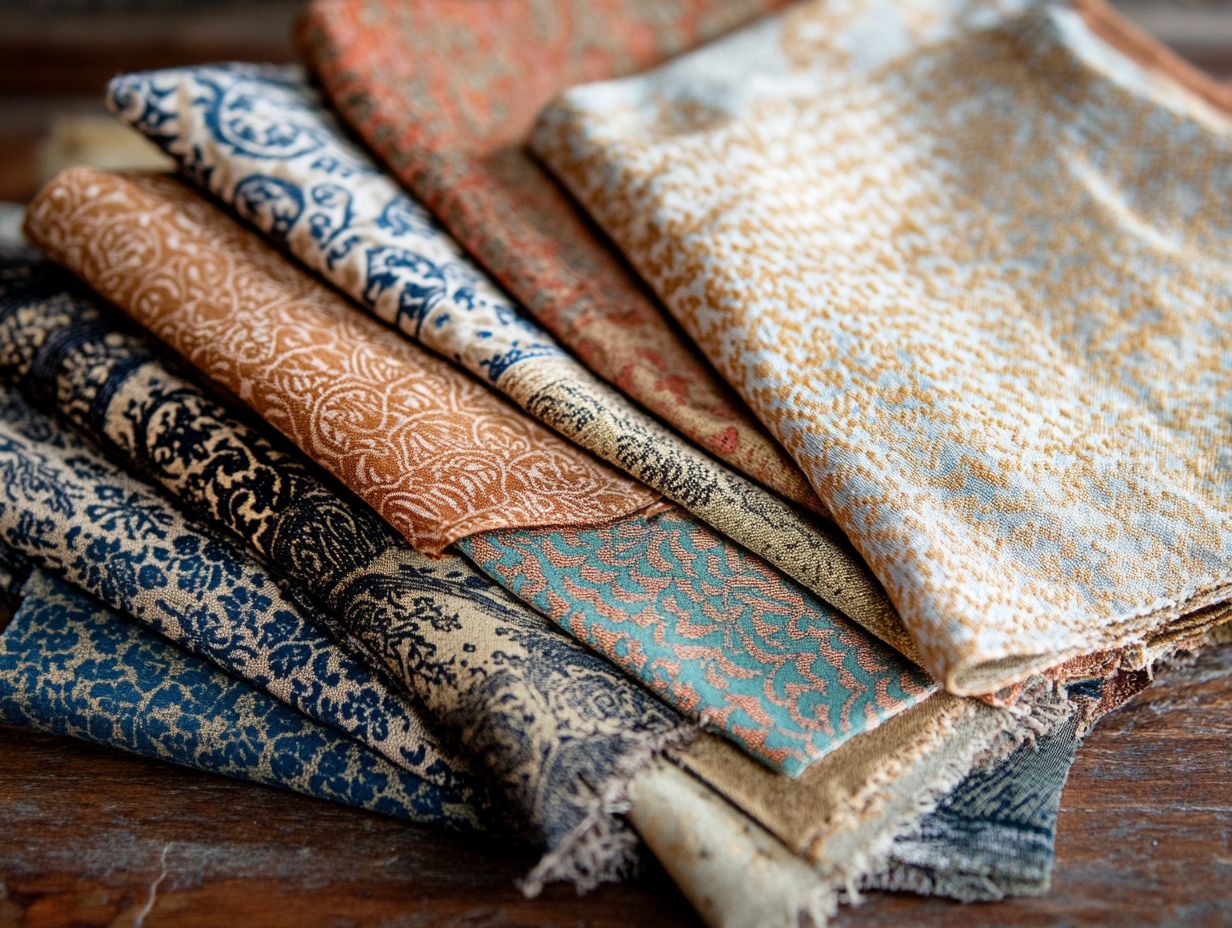
Incorporating vintage fabrics into your modern wardrobe brings back the unique aesthetics of bygone eras. It infuses your contemporary style with a distinctive touch of individuality and character, often highlighted by classic components and patterns.
Explore the world of vintage fabrics today and discover how they can elevate your style!
Tips and Ideas for Styling Vintage Pieces
Styling vintage pieces can be exhilarating yet tricky. With the right tips and ideas, you can craft stunning outfits that honor the fabric’s rich heritage and celebrate their craftsmanship and unique characteristics.
By blending vintage textiles with contemporary designs, such as incorporating bright colors, you can achieve a balanced look that feels fresh while respecting history. Imagine pairing a classic floral vintage skirt with a modern, minimalistic top. This striking contrast showcases the best of both styles, and you can learn more about incorporating vintage textiles into modern decor.
Accessorizing with current trends, like oversized hats or chunky jewelry, can further elevate your ensemble. Don t shy away from mixing and matching patterns think polka dots with stripes to create a visually captivating aesthetic that forges a connection between past and present.
Layering adds depth to your look. Try a tailored blazer over a vintage silk dress or soft wool piece for a sophisticated touch, allowing you to stand out with effortless elegance.
Where to Find Vintage Fabrics
Discovering authentic vintage fabrics can be quite an adventure. You have a plethora of resources at your fingertips, both online and offline, including platforms like Google LLC and specialized websites.
From charming thrift stores, known for their eclectic collection of vintage finds, to specialized boutiques, the hunt for unique textiles awaits you.
Thrift Stores, Online Shops, and More
Thrift stores and online shops are two of the most popular and accessible avenues for uncovering a diverse array of vintage fabrics, including those made from linen and denim, catering to your unique tastes and budget.
While both options have their allure, they also present distinct challenges. Thrift stores can be treasure troves filled with unexpected gems, offering the excitement of in-person exploration where you can inspect fabric quality up close. To ensure you’re selecting the best materials, learning how to identify high-quality vintage fabrics is helpful. However, be prepared for the possibility of limited inventory and the need for some time and patience as you sift through various items, especially those made from cotton and other natural fibers.
Online shops offer a wide variety of fabrics, including wool and rayon, and allow you the luxury of shopping from home. Yet, you may find it tricky to accurately assess the condition and feel of materials through a screen. For those interested in unique options, exploring the world of vintage cotton fabrics can provide inspiration and quality choices.
When you embark on this exciting journey, it’s crucial to evaluate the quality of vintage fabrics carefully. Look for sturdiness, unique textures, and any signs of damage, ensuring that each addition to your collection is satisfying and contributes to the overall history of textiles.
Frequently Asked Questions

What is the definition of vintage fabric?
Vintage fabric refers to any fabric that is at least 20 years old and has unique characteristics that distinguish it from modern fabrics.
What are the most common types of vintage fabrics?
The most common types include silk, cotton, velvet, wool, and linen. These fabrics were widely used in clothing and home decor during the 20th century.
How can I determine the texture of a vintage fabric?
Feel the fabric! The texture of vintage materials often surprises with a soft, worn-in charm. You can also examine the fabric closely for unique patterns or weaves.
What are some common characteristics of vintage fabrics?
Vintage fabrics often feature unique colors or patterns and may show imperfections or signs of wear due to their age. They might also have a slightly different texture compared to modern fabrics.
How can I incorporate vintage fabrics into my home decor?
There are many ways to incorporate vintage fabrics into your home decor. Use them as curtains, throw pillows, tablecloths, or even frame them as wall art. Mixing and matching different vintage fabrics can create a unique and eclectic look.
Where can I find vintage fabrics?
You can find vintage fabrics at specialty vintage stores, flea markets, and online marketplaces. Thrift stores and estate sales are also great options. Don t hesitate to ask family and friends if they have any vintage fabrics they no longer need.
Explore the world of vintage fabrics today and discover the unique stories and styles they bring!


